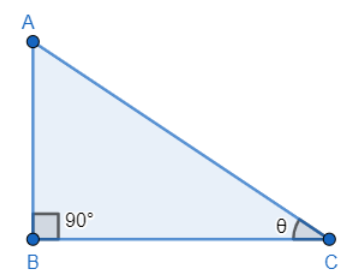
Find the values of other five trigonometric ratios if $\sin \theta =\dfrac{{{a}^{2}}-{{b}^{2}}}{{{a}^{2}}+{{b}^{2}}}$ .
Answer
575.1k+ views
Hint: First we consider a right angled triangle and draw a diagram. We use the Pythagoras theorem to find the length of the side of a right triangle. We use the trigonometric ratio property to find the values of five trigonometric ratios which are $cos\theta ,tan\theta ,cosec\theta ,sec\theta $ and $\cot \theta $.
Complete step-by-step answer:
We have been given the value of $\sin \theta =\dfrac{{{a}^{2}}-{{b}^{2}}}{{{a}^{2}}+{{b}^{2}}}$.
We have to find the values of the other five trigonometric ratios.
First let us consider a right triangle $\Delta ABC$, in which $\angle B=90{}^\circ $.

We know that $\sin \theta =\dfrac{\text{perpendicular}}{\text{hypotenuse}}$ and we have $\sin \theta =\dfrac{{{a}^{2}}-{{b}^{2}}}{{{a}^{2}}+{{b}^{2}}}$.
When we compare both, we get
Perpendicular $AB={{a}^{2}}-{{b}^{2}}$ and hypotenuse $AC={{a}^{2}}+{{b}^{2}}$
Now, we know that according to the Pythagoras theorem in a right angle triangle, the square of the hypotenuse is equal to the sum of squares of the other two sides.
So, for $\Delta ABC$, we have
$A{{C}^{2}}=A{{B}^{2}}+B{{C}^{2}}$
Now, substituting the values we have
\[\begin{align}
& {{\left( {{a}^{2}}+{{b}^{2}} \right)}^{2}}={{\left( {{a}^{2}}-{{b}^{2}} \right)}^{2}}+B{{C}^{2}} \\
& \Rightarrow B{{C}^{2}}={{\left( {{a}^{2}}+{{b}^{2}} \right)}^{2}}-{{\left( {{a}^{2}}-{{b}^{2}} \right)}^{2}} \\
\end{align}\]
Now, we know that
\[\begin{align}
& {{\left( a+b \right)}^{2}}={{a}^{2}}+{{b}^{2}}+2ab \\
& {{\left( a-b \right)}^{2}}={{a}^{2}}+{{b}^{2}}-2ab \\
\end{align}\]
Now, substituting the values, we get
\[\begin{align}
& \Rightarrow B{{C}^{2}}=\left( {{a}^{4}}+{{b}^{4}}+2{{a}^{2}}{{b}^{2}} \right)-\left( {{a}^{4}}+{{b}^{4}}-2{{a}^{2}}{{b}^{2}} \right) \\
& \Rightarrow B{{C}^{2}}={{a}^{4}}+{{b}^{4}}+2{{a}^{2}}{{b}^{2}}-{{a}^{4}}-{{b}^{4}}+2{{a}^{2}}{{b}^{2}} \\
& \Rightarrow B{{C}^{2}}=4{{a}^{2}}{{b}^{2}} \\
\end{align}\]
Or we can write
\[\begin{align}
& B{{C}^{2}}={{\left( 2ab \right)}^{2}} \\
& BC=2ab \\
\end{align}\]
So, we have base \[BC=2ab\]
Now, we know that the values of trigonometric ratios are as follows:
\[\begin{align}
& \cos \theta =\dfrac{\text{Base}}{\text{Hypotenuse}} \\
& \tan \theta =\dfrac{\text{Perpendicular}}{\text{Base}} \\
& cosec\theta =\dfrac{\text{Hypotenuse}}{\text{Perpendicular}} \\
& \sec \theta =\dfrac{\text{Hypotenuse}}{\text{Base}} \\
& \cot \theta =\dfrac{\text{Base}}{\text{Perpendicular}} \\
\end{align}\]
Now, we have Perpendicular $AB={{a}^{2}}-{{b}^{2}}$, hypotenuse $AC={{a}^{2}}+{{b}^{2}}$ and base \[BC=2ab\]
Substituting the values, we get
\[\begin{align}
& \cos \theta =\dfrac{2ab}{{{a}^{2}}+{{b}^{2}}} \\
& \tan \theta =\dfrac{{{a}^{2}}-{{b}^{2}}}{\text{2ab}} \\
& cosec\theta =\dfrac{{{a}^{2}}+{{b}^{2}}}{{{a}^{2}}-{{b}^{2}}} \\
& \sec \theta =\dfrac{{{a}^{2}}+{{b}^{2}}}{\text{2ab}} \\
& \cot \theta =\dfrac{\text{2ab}}{{{a}^{2}}-{{b}^{2}}} \\
\end{align}\]
So, we get the values of all trigonometric ratios.
Note: To solve such types of questions the key concept is to draw a right triangle and apply Pythagoras theorem. Also, it is necessary to remember the formulas of all trigonometric ratios. In a right triangle the side opposite to the right angle is hypotenuse and the other two sides are base and perpendicular.
Complete step-by-step answer:
We have been given the value of $\sin \theta =\dfrac{{{a}^{2}}-{{b}^{2}}}{{{a}^{2}}+{{b}^{2}}}$.
We have to find the values of the other five trigonometric ratios.
First let us consider a right triangle $\Delta ABC$, in which $\angle B=90{}^\circ $.

We know that $\sin \theta =\dfrac{\text{perpendicular}}{\text{hypotenuse}}$ and we have $\sin \theta =\dfrac{{{a}^{2}}-{{b}^{2}}}{{{a}^{2}}+{{b}^{2}}}$.
When we compare both, we get
Perpendicular $AB={{a}^{2}}-{{b}^{2}}$ and hypotenuse $AC={{a}^{2}}+{{b}^{2}}$
Now, we know that according to the Pythagoras theorem in a right angle triangle, the square of the hypotenuse is equal to the sum of squares of the other two sides.
So, for $\Delta ABC$, we have
$A{{C}^{2}}=A{{B}^{2}}+B{{C}^{2}}$
Now, substituting the values we have
\[\begin{align}
& {{\left( {{a}^{2}}+{{b}^{2}} \right)}^{2}}={{\left( {{a}^{2}}-{{b}^{2}} \right)}^{2}}+B{{C}^{2}} \\
& \Rightarrow B{{C}^{2}}={{\left( {{a}^{2}}+{{b}^{2}} \right)}^{2}}-{{\left( {{a}^{2}}-{{b}^{2}} \right)}^{2}} \\
\end{align}\]
Now, we know that
\[\begin{align}
& {{\left( a+b \right)}^{2}}={{a}^{2}}+{{b}^{2}}+2ab \\
& {{\left( a-b \right)}^{2}}={{a}^{2}}+{{b}^{2}}-2ab \\
\end{align}\]
Now, substituting the values, we get
\[\begin{align}
& \Rightarrow B{{C}^{2}}=\left( {{a}^{4}}+{{b}^{4}}+2{{a}^{2}}{{b}^{2}} \right)-\left( {{a}^{4}}+{{b}^{4}}-2{{a}^{2}}{{b}^{2}} \right) \\
& \Rightarrow B{{C}^{2}}={{a}^{4}}+{{b}^{4}}+2{{a}^{2}}{{b}^{2}}-{{a}^{4}}-{{b}^{4}}+2{{a}^{2}}{{b}^{2}} \\
& \Rightarrow B{{C}^{2}}=4{{a}^{2}}{{b}^{2}} \\
\end{align}\]
Or we can write
\[\begin{align}
& B{{C}^{2}}={{\left( 2ab \right)}^{2}} \\
& BC=2ab \\
\end{align}\]
So, we have base \[BC=2ab\]
Now, we know that the values of trigonometric ratios are as follows:
\[\begin{align}
& \cos \theta =\dfrac{\text{Base}}{\text{Hypotenuse}} \\
& \tan \theta =\dfrac{\text{Perpendicular}}{\text{Base}} \\
& cosec\theta =\dfrac{\text{Hypotenuse}}{\text{Perpendicular}} \\
& \sec \theta =\dfrac{\text{Hypotenuse}}{\text{Base}} \\
& \cot \theta =\dfrac{\text{Base}}{\text{Perpendicular}} \\
\end{align}\]
Now, we have Perpendicular $AB={{a}^{2}}-{{b}^{2}}$, hypotenuse $AC={{a}^{2}}+{{b}^{2}}$ and base \[BC=2ab\]
Substituting the values, we get
\[\begin{align}
& \cos \theta =\dfrac{2ab}{{{a}^{2}}+{{b}^{2}}} \\
& \tan \theta =\dfrac{{{a}^{2}}-{{b}^{2}}}{\text{2ab}} \\
& cosec\theta =\dfrac{{{a}^{2}}+{{b}^{2}}}{{{a}^{2}}-{{b}^{2}}} \\
& \sec \theta =\dfrac{{{a}^{2}}+{{b}^{2}}}{\text{2ab}} \\
& \cot \theta =\dfrac{\text{2ab}}{{{a}^{2}}-{{b}^{2}}} \\
\end{align}\]
So, we get the values of all trigonometric ratios.
Note: To solve such types of questions the key concept is to draw a right triangle and apply Pythagoras theorem. Also, it is necessary to remember the formulas of all trigonometric ratios. In a right triangle the side opposite to the right angle is hypotenuse and the other two sides are base and perpendicular.
Recently Updated Pages
Two men on either side of the cliff 90m height observe class 10 maths CBSE

What happens to glucose which enters nephron along class 10 biology CBSE

Cutting of the Chinese melon means A The business and class 10 social science CBSE

Write a dialogue with at least ten utterances between class 10 english CBSE

Show an aquatic food chain using the following organisms class 10 biology CBSE

A circle is inscribed in an equilateral triangle and class 10 maths CBSE

Trending doubts
Why is there a time difference of about 5 hours between class 10 social science CBSE

Write a letter to the principal requesting him to grant class 10 english CBSE

What is the median of the first 10 natural numbers class 10 maths CBSE

The Equation xxx + 2 is Satisfied when x is Equal to Class 10 Maths

Which of the following does not have a fundamental class 10 physics CBSE

State and prove converse of BPT Basic Proportionality class 10 maths CBSE




